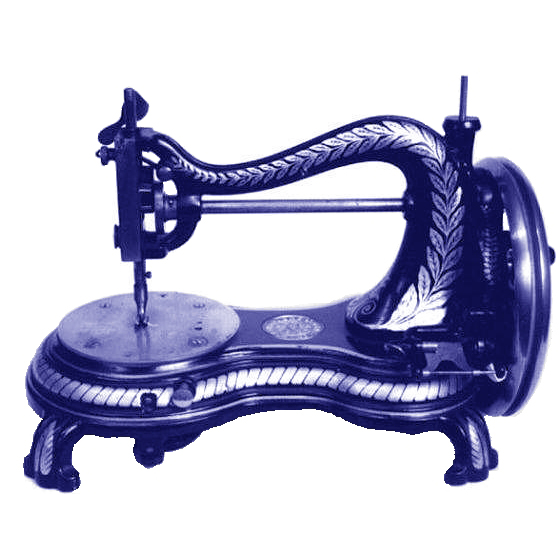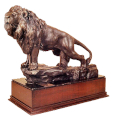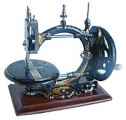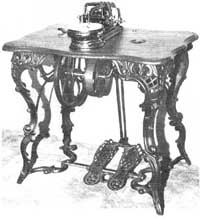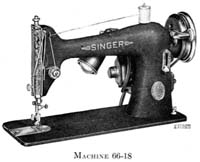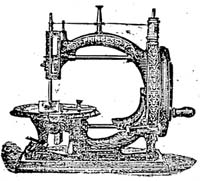The Story of Over-edgers
THE FIRST machines which produced an over-edge stitch were used for buttonholes. It was not until 1877 that a patent was issued which referred to overseaming the edge of a garment of piece of fabric.
The first over-edge machines retained in their design many of the elements used in the lock-stitch machine, a natural tendency, since the lock-stitch machine was the first to get commercial acceptance.
In 1854, a patent was issued to Charles Miller for a machine to produce the herringbone or whipstitch buttonhole stitch, the earliest mention of an over-edge stitch. His patent made claims to cover the lateral movement of the cloth with regard to the direction of the seam so as to produce an inter-lacing stitch of needle and shuttle threads. The idea of applying the lock-stitch machine to the finishing of buttonholes was there, but Mr Miller did not include it in his patent claims.
In 1859, Goodes and Miller received a patent for a single-thread over-edge stitch for use on buttonholes, Stitch Type 501. The machine used a vertical eye-pointed needle and two hook-pointed spreaders. One of the spreaders functioned below the fabric and picked up the needle loop, and the other spreader operated to pick the needle loop off the bottom spreader and move the loop to the top of the fabric where the needle could enter its loop. This was without a shuttle, a great stride.
In 1860 Jacob Steiner received a patent for a machine to over-edge buttonholes, using a needle and one spreader in conjunction with a shuttle. The needle was eye-pointed and reciprocated vertically. When the needle descended through the cloth the shuttle passed through the needle loop, after which the spreader caught the shuttle thread and carried it past the edge of the fabric and under the descending needle.
The spreader was shaped like a cork screw and was driven in a vertical spiral path from below the fabric. The machine produced the first two-thread over-edge stitch but was unsuccessful because of a complexity of parts. Steiner's efforts to convert the machine to either an over-edge or lock-stitch machine were also unsuccessful.
In 1860 a patent was issued to I M Rose for a buttonhole machine for producing a two-thread stitch. A shuttle located below the fabric containing a thread-filled bobbin performed the necessary stitch forming functions. This was the simplest adaptation of the lock-stitch machine to over-edge seam construction.
The machine differed from the Miller machine in that the fabric did not have to be moved laterally to the seam during the formation of each stitch. The eye-pointed needle passed through the fabric and the shuttle would then pass through the needle loop. A small finger would then catch the shuttle thread next to the shuttle, carry it past the edge of the fabric, and under the descending needle where the shuttle thread would be locked.
In 1863, a patent was issued to George Rehfuss, later associated with the American Buttonhole Sewing machine Company, for over-edging buttonholes, cording and braiding. His machine, with its eye-pointed needle, lower-thread-carrying looper and spreader, produced the first Stitch Type 503. He also used rotary and oscillating shuttles in place of his lower looper.
Perhaps most interesting was his substitution of the lower looper with another needle that moved up from the bottom of the fabric on a 45-degree angle, entering the vertical sewing needle loop, passing the edge of the fabric, and transferring its thread loop to a spreader that carried the loop to the path of the descending vertical needle. His patent made reference to the use of the over-edge or edge stitch for purposes other than the finishing of a buttonhole.
1865-Throat plate-stitch tongue
A patent was issued to Jacob Frey for an over-edge machine, which contained claims for a stitch tongue on which to form the stitch. The claims covered both the throat plate and cloth plate.
A patent was issued to Joseph Merrow for an over-edge crocheting machine which contained claims for a stitch tongue on the presser foot s well as the throat plate.
1889-Automatic trimming on over-edge machine
In 1889, the first automatic trimming device to be used on an over-edging machine was claimed in a patent issued to H H Fefal. The trimmer had a stationary vertical lower knife and an oscillating top knife, which for all practical purposes is used in the same form today.
A patent was issued to Joseph Merrow for an over-edge machine using three threads. The machine contained a curved, eye-pointed needle, which operated in conjunction with an under and cover thread looper. Each looper carried its own thread. The looper under the fabric picked up the needle loop from the needle. The cover thread looper picked up from the under looper a loop formed from the under-looper thread. The cover thread looper then moved past the edge of the fabric to the top of the fabric. At this point the descending needle entered the triangle formed from the thread carried in the top of cover thread looper. This machine is the forerunner of the three-thread over-edging machines used today.
In 1903, a patent was issued to Joseph Merrow of the Merrow Machine Company, for an over-edge machine to produce stitch type 505.
In 1914, a patent was issued to J P Weis and C E Johnson for a multiple-needle over-edging machine. The machine had four needles, one looper, and one combination looper and spreader. Although this machine did not make the exact stitch known to us a stitch type 506, stitch type 506 could be constructed by using only two of the four need-les. Mr Weis was with the Metropolitan Sewing Machine Company.
The Union Special Machine Company developed the formation known as the "Safety Stitch", which not only covers the trimmed edge with a four-thread interlock stitch type 602, but parallels it with a separate row of the double-locked stitch type 501. The patent which shows this type of stitch formation was issued to James R Moffatt of the Union Special Machine Company in 1919.
Several Union Special men including Messrs Onderdonk, Woodward and Maier, received a number of patents on over-edge machines, mechanisms, and stitch formations, starting with 1895.
This story was prepared from information contained in an early Union Special document.
